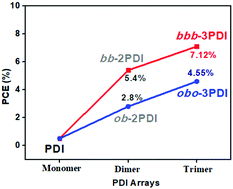Perylene diimide arrays: promising candidates for non-fullerene organic solar cells†
Abstract
Herein, two perylene diimide (PDI) trimer arrays (bbb-3PDI and obo-3PDI), which are coupled at different reactive positions of the PDI monomer, have been efficiently synthesized and comprehensively investigated. The photophysical and electrochemical properties indicate that these two compounds exhibit much strong absorption in the visible region and suitable lowest unoccupied molecular orbital (LUMO) levels. In addition, the density functional theory (DFT) calculations indicate that the compound bbb-3PDI possesses stronger abilities of accepting electrons from donors and donating holes to the donor materials; thus, this compound is beneficial for exciton dissociation in OSCs. Upon choosing an appropriate energy level alignment and PTB7-Th with well-matched absorption as electron donors, the active layer of PTB7-Th:bbb-3PDI exhibits favorable morphology, higher carrier mobilities, and more balanced carrier transport. As a result, the device based on PTB7-Th:bbb-3PDI shows a high power conversion efficiency (PCE) of 7.12% and a high short circuit current (JSC) of 18.13 mA cm−2, which are the highest values obtained for the PDI-array-based non-fullerene OSCs. The obtained performance based on bbb-3PDI is significantly higher than those of obo-3PDI (4.55%) and the PDI dimer arrays; this highlights the potential of the PDI trimer arrays to realize high-efficiency non-fullerene OSCs.



 Please wait while we load your content...
Please wait while we load your content...